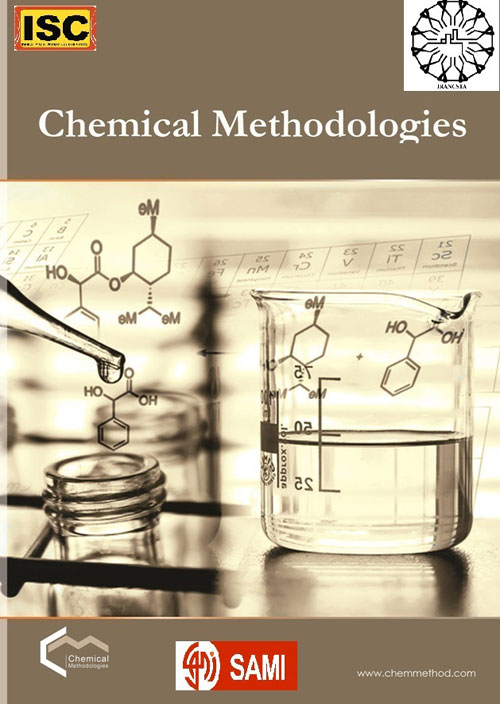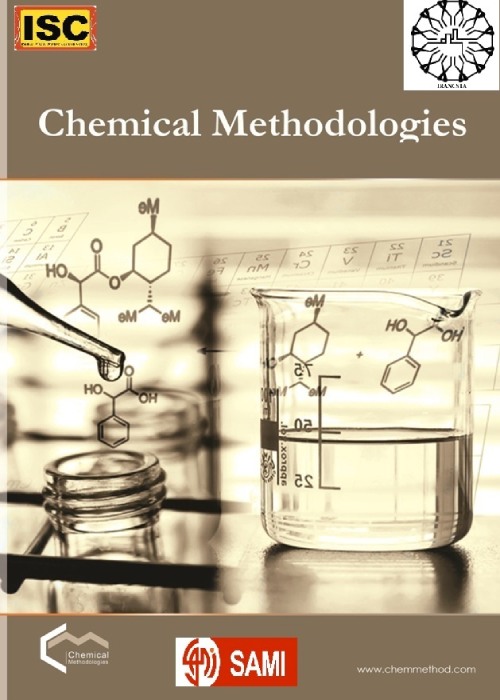فهرست مطالب

Chemical Methodologies
Volume:6 Issue: 12, Dec 2022
- تاریخ انتشار: 1401/06/27
- تعداد عناوین: 10
-
-
Pages 905-913A new Azo-Schiff base ligand was prepared by reaction of 2-aminobenzothiazole and 2-hydroxy-1-naphthlaldehyde to form the azo compound. In the latest step, the azo compound was reacted with thiosemicarbazide to give the ligand. The synthesized ligand was used for complexes with different metal ions like Ni(II), Co(II), Cr(III), Mn(II), and Cu(II) by using a molar ratio of ligand: metal as 1:2. Resulted in compounds were characterized by FT-IR, 1HNMR, 13CNMR, UV–Vis spectroscopy, Mass, elemental analysis, magnetic moment and molar conductivity studies. The ligand and its complexes’ activity were tested against four types of bacteria and one type of fungi; some compounds gave a positive result, and others showed negative inhibition.Keywords: Azo, Schiff base 2-Aminobenzothiazole 2-Hydroxy-1-naphthlaldehyde Metal complexes Thiosemicarbazides
-
Pages 914-928In the present study, mixed ligand compounds of Mn(II), Ni(II), Co(II), Cu(II), Cd(II) and Hg(II) were synthesized using new Ligand N1,N4-bis (pyrimidin-2-ylcarbamothioyl) succinimide (NPS) derived from [Butanedioyl diisothiocyanate with 2- aminipyridine] as first ligand, and proline (pro) as second ligand and evaluation of their antioxidant activities for ligand, nickel and cobalt complex towards 1.1-Di-phenyl-2picrylhydrazyl (DPPH) were compared with the standard anti-oxidants (i.e. the ascorbic acid). The materials led to the results that came from exhibiting different activities of the radical scavenging for all of the compounds. The compounds observed were then confirmed through the Fourier-transform infrared (FT-IR), proton nuclear magnetic resonance (1 HNMR), ultraviolet-visible (UV-vis), micro-elemental analyses (CHNS), thermal analysis (TGA), carbon13 nuclear magnetic resonance (13CNMR), atomic absorption flame (AAF), magnetic susceptibility and conductivity. The proposed geometry for all complexes [M2(NPS)(pro)2]Cl2 was tetrahedral. Furthermore, the antibacterial and antifungal activity was screened for the DMSO solution concerning the ligand (NPS) and its complexes against two kinds of gram; (Staphylococcus aureas) positive and (Esherichia coli) negative and against (Candida albican) fungi.Keywords: Succinyl chloride 2, Aminopyrimidine Biological activity Antioxidation
-
Pages 929-939To reflect modern practice in lab experiments, they should include a range of elements. Mixed new complexes of metal chloride for Rh(III) and Au(III) synthesis by the condensation reaction of metals with sodium fusidate as a primary ligand with the secondary ligand represented by 2,2-bipyridine (L/) in boiling ethanol and synthetic tasks are accompanied by characterization and analysis in the solid state based on the results of the color, melting points, metal composition percent and other elements (C, H, and N), the spectroscopic measurement acts by UV-Vis and FT-IR, magnetic susceptibility, and electrical conductivity measurements. The results of this study reveal the coordination sites for the ligands with the metal ions as bidentate through two oxygen atoms of the sodium fusidate, while bipyridine via diimine nitrogen atoms. Analytical and spectroscopy studies disclosed octahedral structure for Rh(III) complex and square planner structure of Au(III) complex. The ligands and both inclusions of new complexes were screened against bacterial and fungal strains (Escherichia coli as gram (-), Staphylococcus aurous as gram (+) and Candida albicaons) at three selected concentrations (50, 100, and 200 ppm) and their preliminary results compounds exert the cell surface damage observed by scanning electron microscopy (SEM) and the Au(III) complexes exhibit the superior antimicrobial activity particular in a high concentration (200 ppm).Keywords: Experiments, essential, mixed, sodium fusidate, Diamine, Bidentate, Damage
-
Pages 940-952The titanium dioxide nanoparticles were synthesized by the sol-gel method, while the copper oxide nanoparticles (CuO) were synthesized by the green method by using Sidr extract. The nanocomposites were prepared from the condensation reaction of polystyrene (PS), TiO2, CuO, and (GO) by simple mixing method. These structure (PS/GO/CuO) and (PS/TiO2/CuO) were characterized by FE-SEM, X-rays diffraction, and thermal analysis. The measurements showed that PS/TiO2/CuO and PS/GO/CuO of the synthesized were present in nanoparticle size within the nano-scale. The nanocomposites were tested in the applications of biological activity as antibacterial, antifungal, and antioxidant. The results showed that the nanocomposites (PS/GO/CuO) gave a higher inhibition value than (PS/TiO2/CuO) nanocomposites with bacteria.Keywords: plystyrene, graphene oxide, CuO, TiO2 metal oxide nanoparticles
-
Pages 953-961The novel compounds were prepared to start from cephalexin in this work. It was converted into five-membered rings (1,3-oxazole and 1,3-thiazole). The cephalexin was reacted with ethanol absolute and hydrochloride at first to obtain compound (2), and in the second step, compound (2) reacted with thiourea to obtain a compound (3), then compound (2) reacted with urea to obtain a compound (4); when compound (4) was reacted with 4-phenyl phenacyl bromide, we got 1,3-oxazole derivative from this reaction, also when compound (3) reacted with 4-phenyl phenacyl bromide in the presence of absolute ethanol, we got 1,3-thiazole derivative. The melting points of the synthesized compounds were recorded, the purity was checked by TLC, and the structures of the prepared compounds were identified by FT-IR and 1H-NMR spectra. The biological activity of these compounds was tested.Keywords: 3-Oxazole 1, 3-Thiazole Biological Activity FT-IR, 1H-NMR spectra
-
Pages 962-976
[4-Chloro-5- (N-(5,5-dimethyl- 3-oxocyclohex-1-en-1-yl) sulfamoyl)-2- ((furan-2-ylmethyl) amino) benzoic acid] is the ligand[H2L1]. [H2L1] was synthesized and identified using Fourier transform infrared (FT-IR), 1H, 13C-NMR, CHN, mass spectra, and UV-Vis spectroscopy methods. To detect mixed ligand complexes, analytical and spectroscopic approaches such as micro-analysis, conductance, UV-visible, magnetic susceptibility, and FT-IR spectra were utilized. Its mixed ligand complexes [M(L1) (Q)Cl2] and complexes [Pd(L1) (Q)] and [Pt(L1) (Q)Cl2]; [H2L1] = β-enaminone ligand =L1 and Q= 8-Hydroxyquinoline = L2]. The results showed that the complexes were synthesized utilizing the molar ratio M: L1:L2 (1:1:1). For the metal complexes Co(II), Ni(II), Cd(II), and Pt(IIII), a six-coordinate octahedral geometry was proposed, whereas the Pd(II) complex was square planar. By Using the agar well diffusion method, the ligands and complexes were evaluated for antibacterial activity against Staphylococcus aureus and Escherichia coli. The studies demonstrate that the ligand and its complexes have variable activity against the bacterial types. Some of the complexes had an effect on affected bacteria, while others had less inhibitory action than the ligand. Also, the produced ligand and its metal complexes have been tested for fungi (Candida albicans); the complexes exhibited suppressing activity against fungi compared to the ligand prepared from them.
Keywords: β-Enaminones 5, 5-dimethylcyclohexane-1, 3-dione Furosemide Mixed-ligand complexes 8-Hydroxyquinoline -
Pages 977-984Iron oxide nanoparticles are one of the most important materials in nanotechnology due to their unique properties in many fields. In this research, iron oxide nanoparticles are synthesized by using new homemade autoclave reactor with hydrothermal method. Many studies of iron oxide nanoparticles have been studies, including surface morphology, structural morphology, and optical studies. The XRD characteristics of the pattern show very thin peaks, indicating the nanoparticles formation with average crystallite size about 26 nm. The SEM and FE-SEM analyses reveal the formation of the nanoparticles with spherical shape and size ranging from 35 nm to 45 nm. The spherical particles are exhibiting the high levels of aggregation due to the innate tendency to the magnetic characteristics. The EDX verified that there were only percentages of oxygen and iron in the nanoparticles. The FT-IR analysis for the iron oxide showed that the absorption peaks at about 430 and 630 cm−1 are observed corresponding to stretching modes of the Fe-O bond in maghemite. Finally, the optical properties of the iron oxide sample reveal a broad absorption band area with energy band gap about (2.08 eV) which are nearly about the energy band gap of standard iron oxide which is equal to (2.2 eV). Therefore, all studies showed the autoclave reactor is a powerful tool to form iron oxide nanoparticles with a high purity and the ultra-fine particle size.Keywords: Hydrothermal, Iron oxide, XRD
-
Pages 985-996The spinel compound of LiCo0.5Mn1.5O4 (LCMO) was synthesized as cathode active material for lithium–ion batteries by using sol–gel technique in this study. The substance was subjected to a thermo-gravimetric (TGA) study. The sample was calcined in the air for 12 hours at 700, 850, and 1000 ᵒC to examine differences in structural and morphological features. The thermogravimetry (DTG) curve of sample was fabricated at 850 °C. A loss region took place before 400 °C related to the evaporation regarding the adsorbed water molecules and the elimination of oxygen-containing functional groups. The powder crystallized in the phase structure space group Fd⋽m and has a random orientation, according to the XRD measurement. The LCMO powder's surface morphology comprises nano-grains crystallite with a homogeneous coverage of the sample surface and randomly oriented grains. LiCo0.5Mn1.5O4 synthesized at 850°C was taken after one charge/discharge cycle. The interfacial layer resistance, or Rf, is attributed to the impedance of Li+ ion migration through SEI film. From the EIS measurements, the diameter of the semicircle equal to charge transfer resistance, which is approximately 700 Ω. The capacity of the charging and discharging were of 121 mAhg-1 and 122 mAhg-1 delivered by the LiCo0.5Mn1.5O4 cathode. Likewise, a columbic efficiency of 94% was obtained for the cathode.Keywords: Li ion battery, Spinel cathode, Space group, Discharge Capacity, TGA
-
Pages 997-1006The previous effort involved the synthesis of unprecedented Schiff's bases compounds of hydrazine hydrate linked with ethyl 4-hydroxybenzoate, which in turn reacted with carbon disulfide (CS2) and potassium hydroxide (KOH) as catalyst to synthesize 2-marcapto-1,3,4-thiadiazole which reacts with methyl bromoacetate in the presence of triethyl amine N(CH2CH3)3 to form an ester whose methoxy group is converted into a hydrazide, and then reacts with different aromatic aldehydes to form Schiff bases, from which the thiazolidinone and oxazolidinonefive-membered ring heterocyclic compounds' derivatives were formed. All synthetic substances have high yields. The melting points of all compounds and some of their 1H-NMR and FT-IR spectra, were used to authenticate their identities.Keywords: Heterocyclic compounds Thiadiazole 5-Aryle, 4-thiadiazole Schiff base Oxazolidinone Thiazolidinone
-
Pages 1007-1022A [VO(II), Mn(III), Fe(II), Co(II), Ni(II), Cu(II), and Pt(IV)] complexes prepared from 4-((benzo [d] thiazol-2-yl imino) methyl)-5- (hydroxymethyl)-2-methylpyridin 3-ol, ligand (HL1) Schiff bases is newly synthesized which is derived from the reaction between one equivalent of (pyridoxal hydrochloride) and one equivalent for (2-aminobenzothiazole). Multiple techniques and devices were used to diagnose the prepared compounds. Among these techniques are Melting Point Measurements, Fourier Transform Infrared Spectra, Conductivity Measurements, Electronic spectra UV-Vis., Mass Spectroscopy, Metal Analysis, Elemental Microanalysis, Magnetic Moment Measurement, Thermal Gravimetric Analysis TGA, 1H, and 13C-NMR Spectra. Then, it was measured the biological activity of the prepared compounds against four types of bacteria (Klebsiella pneumoniae and pseudomonas) (G-), (Staphylococcus aureus and bacillus subtilis) (G+), and a one type of fungus (Candida albicans).Keywords: Pyridoxal 2, aminobenzothazol FT, IR UV, Vis


